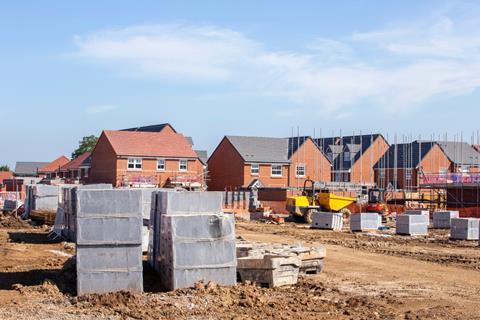Latest prediciton shows impact of rising cost pressures and war in Ukraine
The Construction Products Association has cut its forecast for housebuilding growth this year and next in the face of rising concerns over construction costs and increasing financial pressures on potential homebuyers.
The CPA said it now expected housing output to grow by 1% both this year and next year, compared to growth of 3% in 2022 and 2023 that it forecast just three months ago, prior to the onset of war in Ukraine.

The industry body said it expected housebuilding starts to rise by the same amount, 1%, this year and next, before growing more strongly, by 3%, in 2024. Completions will rise by 2% this year and next, it added.
The CPA said that while private housebuilders had so far seen good demand for new homes, it said that “looking forward, however, it is difficult to see demand and supply issues being so amenable”, adding that “the extent of the shock facing households due to price rises is likely to be larger than at any time during the 1970s […]. Intuitively, the drop in household incomes and consumer confidence would point towards a sharp fall in housing demand.”
However, the forecast said it was not clear to what extent this squeeze on households would feed through into a drop in demand for new homes, given that wealthier homebuyers were likely to be less affected by the cost of living crisis.
The housing forecasts were parts of the CPA’s wider construction forecast, which found that output growth would come in at 2.8% in the second quarter – down from the 4.3% growth forecast just three months ago.
The CPA said the industry was being hit by ongoing labour and products shortages as well as the costs of the reverse charge VAT and IR35.

It added: “Prior to the conflict in Ukraine, UK construction was already facing labour and product availability issues and the impact of. Rising energy costs were driving near-record price increases in construction products and the continued conflict is exacerbating this issue.”
The CPA said demand remains strong, with the current project pipeline suggesting this will continue throughout Q3 and into the autumn.
But it warned that contractors are beginning to feel the effects of cost pressures now, especially those working on fixed-price deals.
“For future projects, contractors will be forced to re-price, add fluctuation costs and introduce risk-sharing arrangements to deal with the uncertainty over potential cost inflation,” it said.
Noble Francis, CPA economics director, added: “The major challenge is creeping uncertainty. The immediate picture is one of resilient demand and healthy pipelines. Longer term, the current inflationary pressures, if sustained, will have an increasingly depressing impact.
“Specialist sub-contractors are feeling the effects first, particularly those working to fixed-price contracts. For future projects, contractors will be forced to re-price, add fluctuation clauses and introduce risk-sharing arrangement to deal with the uncertainty over potential cost inflation.”
In private housing repair, maintenance and improvement, the CPA said the sector was arguably most exposed to current price inflation, falls in consumer confidence and pressures on household incomes. Overall, output is expected to fall by 3% in 2022 and 4% next year from current all-time highs.
The fastest growth is expected in the industrial sector, in which output is forecast to rise by 9.8% in 2022 and 9.3% in 2023, due to a strong pipeline of warehouse projects, resulting from a long-term shift towards online shopping.
Infrastructure, which is traditionally less affected by immediate economic conditions, remains positive. Large projects such as HS2, Thames Tideway and Hinkley Point C combined with the five-year spending plans in regulated sectors such as rail, road and power generation point to a forecasted growth of 8.8% in 2022 and 4.6% in 2023.
On the supply side, it said the main immediate impact of the war in Ukraine for construction products will be the knock-on from rising energy prices and commodity shortages with aluminium, steel, bricks and cement all affected.











No comments yet